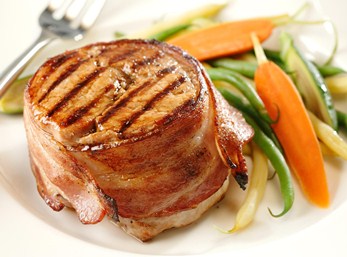A (Juicier) Reason to Be Inspired by Pork
01 June 2011
 New USDA guidelines lower pork cooking temperature by 15 degrees Fahrenheit, to the delight of chefs and consumers throughout America.
New USDA guidelines lower pork cooking temperature by 15 degrees Fahrenheit, to the delight of chefs and consumers throughout America.
New cooking guidelines from the nation's food-safety agency confirm Pork Checkoff research that shows pork can be consumed safely when cooked to an internal temperature of 145°F, followed by a three-minute rest time. The guidelines were announced in May by the U.S. Department of Agriculture's Food Safety Inspection Service (FSIS).
The new recommended temperature is a significant 15 degrees less than what was previously recommended and typically will yield a finished product that is pinker in color than most consumers are accustomed to.
"Our consumer research has consistently shown that Americans have a tendency to overcook common cuts of pork, resulting in a less-than-optimal eating experience," said Dianne Bettin, a pork producer from Truman, Minn., and chair of the Checkoff's Domestic Marketing Committee. "The new guidelines will help consumers enjoy pork at its most flavorful, juicy—and safe—temperature."
The revised recommendation applies to pork whole-muscle cuts such as loin, chops and roasts. Ground pork, like all ground meat, should be cooked to 160°F. Regardless of cut or cooking method, both the USDA and National Pork Board recommend using a digital cooking thermometer to ensure an accurate final temperature.
The new recommendation evolved from a 2007 Pork Checkoff-funded research project conducted by Ohio State University to measure consumer eating preferences. As part of that project, the university researchers tested how various end-cooking temperatures affected eating preferences. But the researchers needed to know if temperatures below 160 degrees would be safe if that turned out to be consumers' preference.
That question resulted in a Checkoff-funded research project with Exponent Inc., an engineering and scientific consulting firm, to conduct a risk assessment to evaluate any food-safety implications of cooking temperatures within a range of 145°F to 160°F.
The risk assessment found that cooking pork to an internal temperature of 145°F was equivalent to cooking pork to 160°F. Checkoff-funded research conducted by Texas A&M supports the fact that meat temperature continues to rise after being removed from the heat and the reality that "resting time" between cooking and eating is at least that long. Therefore, FSIS agreed that the cooking temperature for pork could be lowered.
The USDA guidelines for pork now mirror doneness advice for other meats.
The new recommendation reflects advances in both food safety and nutritional content of pork in recent years. On average, most common cuts of pork are 16% leaner than 20 years ago, and saturated fat has dropped 27%. In fact, pork tenderloin is now as lean as the leanest type of chicken—a skinless chicken breast.
In addition to the new recommendation to cook pork to 145°F followed by a three-minute rest time, the USDA food preparation guidelines advise the following:
- Clean: Wash hands and surfaces often.
- Separate: Don't cross-contaminate.
- Cook: to proper cooking temperatures.
- Chill: Refrigerate promptly.
The National Pork Board has responsibility for Checkoff-funded research, promotion and consumer information projects and for communicating with pork producers and the public. Through a legislative national Pork Checkoff, pork producers invest $0.40 for each $100 value of hogs sold. The Pork Checkoff funds national and state programs in advertising, consumer information, retail and foodservice marketing, export market promotion, production improvement, technology, swine health, pork safety and environmental management.
Additional information about cooking pork, including recipes, is available at PorkBeInspired.com, or Facebook.com/PorkBeInspired.
Photo: Bacon-Wrapped Pork-Tenderloin Medallions with Garlic-Mustard Butter. Courtesy of the National Pork Board
